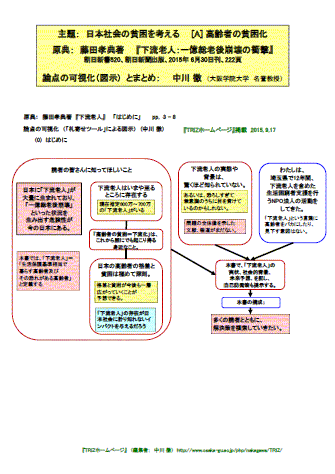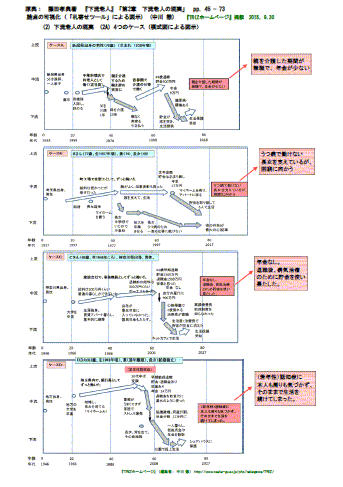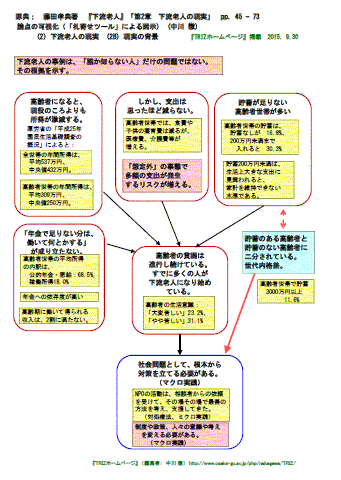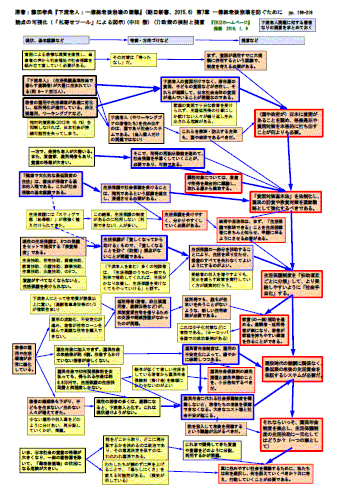 Forum: Social Problems Forum: Social Problems |

 
|
Thinking over the Poverty in the Japanese Society with Visualization:
[A] Increasing poverty among the elderly
[1] Executive summary with visualization of Takanori Fujita's "The Low-living Elderly" Book |
Toru Nakagawa (Osaka Gakuin University),
Jan. 28, 2016; Mar. 6, 2016
|
Brief English translation, Posted on Mar. 6,2016
|
 |
Visual Thinking with 'Fuda-Yose' (13) -- Thinking over the poverty in the Japanese Society: [A] Increasing poverty among the elderly (8)Executive summary of visualizing "The Low-living Elderly" Book |
| Posted on Mar. 3; Mar. 6, 2016 |
For going back to Japanese pages, press  buttons.
buttons.
 Editor's Note (Toru Nakagawa, Mar. 6, 2016) For People interested in Social Problems [Translation of the Japanese page (Jan. 28, 2016)]
Editor's Note (Toru Nakagawa, Mar. 6, 2016) For People interested in Social Problems [Translation of the Japanese page (Jan. 28, 2016)]
Source reference: "Karyuu Roujin" ("The low-living elderly") by Takanori Fujita (Asahi Paperbacks 520, Jun. 2015, pp.222).
For the readers principally interested in social problems, I am going to start a new series of pages here.
The document visualizing Mr. Takanori Fujita's book "The Low-living Elderly" has been completed, and is now posted in the PDF version of a pamphlet of 23 pages  in Japanese.
in Japanese.
The Author pointed out:
"The low-living elderly are defined here as the aged people who live at or lower than the social welfare level. It is estimated that there exist about 6 to 7 million of them in Japan at moment. Recent increase in the number of non-regular employments and decrease in the average income in Japan, the poverty is spreading widely among the young and middle-aged people. Thus there is a high risk that in the near future the lives in the aged days may become miserable for most of the Japanese people."
On the basis of author's experiences of NPO welfare activities, he describes various cases of individuals, and discusses what should be done by individuals, society, government, etc. The book is written carefully, systematically, and deeply.
Nakagawa read this book closely and represented the logic of the whole book with visualizing diagrams. Such diagrams are very helpful for understanding the problem personally and for discussing in a group.
Examples of style of the visualized diagrams and references of the Visualizing software ('Fuda-Yose' Tool) are also shown in this page for new comers.
I wish many people read this Fujita's book, think over with the help of the diagrams, and proceed to real activities in Japanese society.
 Editor's Note (Toru Nakagawa, Mar. 30, 2016)
Editor's Note (Toru Nakagawa, Mar. 30, 2016)  : See the new page: Introduction to "The Low-living Elderly" book by Takanori Fujita (2015) (Introduced by Toru Nakagawa in English)
: See the new page: Introduction to "The Low-living Elderly" book by Takanori Fujita (2015) (Introduced by Toru Nakagawa in English) 
 Editor's Note for experienced readers (Toru Nakagawa, Mar. 6, 2016) [Translation of the Japanese page (Jan. 28, 2016)]
Editor's Note for experienced readers (Toru Nakagawa, Mar. 6, 2016) [Translation of the Japanese page (Jan. 28, 2016)]
Forum: Visual Thinking with 'Fuda-Yose' (13) -- Thinking over the poverty in the Japanese Society:
[A] Increasing poverty among the elderly
(8) Executive summary of visualizing "The Low-living Elderly" Book
Toru Nakagawa (Jan. 28, 2016)
The document visualizing Mr. Takanori Fujita's book "The Low-living Elderly" has been completed, and is now posted in the PDF version of a pamphlet of 23 pages in Japanese.
Table of Contents, Preface of the pamphlet, Visualized diagram of the Introduction part of the source book, and the Proposals in the last chapter of the source book (as summarized by Nakagawa) are posted in the HTML format in the Japanese page  .
.
All the visualized diagrams are readjusted using larger fonts and portrait style.
See also the Index page 
 .
.
----- This is the same page as the one shown above. This face is for the readers of original "TRIZ Home Page" and the above face is for the readers newly coming in with the main interest in social problems.
 Editor's Note (Toru Nakagawa, Mar. 6, 2016) On Visual Thinking (Method and Tool)
Editor's Note (Toru Nakagawa, Mar. 6, 2016) On Visual Thinking (Method and Tool)
The (free) styles of diagrams for 'Visual Thinking' are illustrated here with some pages of the pamphlet  .
.

Page 2: Preface of the book |
|

Page 5: Chapter 2: Four actual cases of falling down |

Page 6: Chapter 3: Anybody has the risk of falling down |
|

Page 21: Chapter 7:
Proposals of policy
|
These diagarams were made in a process similar to the one described in the following page:
Visual Thinking with 'Fuda-Yose' (3) - Visualizing the logic of Sickafus' Paper 'Subconscious Problem Solving Using Hazy Heuristics', Toru Nakagawa and Akihiro Katahira (Japanese page : Aug. 25, 2015, English page
: Aug. 25, 2015, English page : Sept. 17, 2015).
: Sept. 17, 2015).
(Note: This artile was written at the early stage of my using the tool. In a month or two, I was much more fluent in using it.)
The software tool for Visual Thinking, named 'Fuda-Yose' Tool, was originally developled by Akihiro Katahira. It is just an Excel file with a set of macros for drawing/handling some figure forms easily. The tool and its philosophy are described in the following pages:
Introduction to Visual Thinking Software 'Fuda-Yose Tool' and Its Web site 'Thinking School I', Akihiro Katahira (Englis translation by TN), 
 (Jan. 18, 2015)
(Jan. 18, 2015)
Fuda-Yose Tool for Visual Thinking -- English Edition Available, Akihiro Katahira and Toru Nakagawa, 
 (Sept. 30, 2015)
(Sept. 30, 2015)
The 'Fuda-Yose' Tool is publicly available (for evaluation use at moment) by downloading from Katahira's Web site: 
'Fuda-Yose' Tool English Edition (Edition 4.0.1): Download page :  http://members3.jcom.home.ne.jp/dai1kousha/zukou2-e.html
http://members3.jcom.home.ne.jp/dai1kousha/zukou2-e.html
User interfaces, instructions, demonstration tools, etc. are available in English in the tool itself.
Last updated on Mar. 30, 2016. Access point: Editor: nakagawa@ogu.ac.jp




